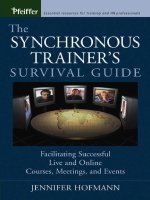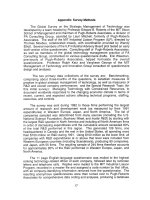education the synchronous trainers survival guide phần 3 docx
Bạn đang xem bản rút gọn của tài liệu. Xem và tải ngay bản đầy đủ của tài liệu tại đây (481.12 KB, 15 trang )
• What tools are available for whiteboard drawing?
• Can drawing and graphics be moved once they are on the whiteboard?
SYNCHRONOUS FEATURE: SURVEYS/POLLS/FEEDBACK/
HANDRAISING/ PACING/COMPREHENSION
Various devices have been built into synchronous platforms to compensate for the
loss of eye contact and body language.
A variety of survey, polling, and feedback tools are available in all platforms. They
help you to get a quick check on the pulse of the class and allow the participants to
appraise the trainer on the pace and clarity of the content.
USES
• Use surveys and polls to determine whether the participants understand the mater-
ial and to keep them tuned in to the lesson.
• Use surveys to transition to a new topic by asking questions about the new topic
and then commenting on the results.
• Create icebreakers and introductory exercises by polling the audience.
• Share results with the class to foster a sense of community.
• Asking participants to provide feedback can be a good reengagement technique if
the audience is not participating.
AN INTRODUCTION TO THE SYNCHRONOUS CLASSROOM 19
vClass Polling Menu
Instructor Feedback Results in LearnLinc
T
ABLE
1.1. Common Synchronous Features and Their Uses, Cont’d.
Hofmann.c01 7/8/03 10:59 AM Page 19
• Anonymous feedback allows participants to be honest without worrying about
repercussions.
• If you are not comfortable with receiving and responding to continual feedback,
you might introduce this feature slowly.
CONSIDERATIONS
• What survey and/or polling tools are available with the platform?
• Can the results be shared with the class?
• Can questions be created spontaneously?
• Is the feedback anonymous/confidential?
SYNCHRONOUS FEATURE: TESTING/EVALUATION
This feature allows the trainer to conduct pre-session and post-session assessments
and tests, the results of which can be automatically tabulated and saved.
USES
• Use this feature to assess your participants’ comprehension and retention.
• If these built-in solutions aren’t robust enough, savvy users can create assessments
in HTML and post them to participants using the application window. Or partici-
pants can be instructed to use commercial web-based assessment tools like
QuestionMark™ (www.questionmark.com) and Zoomerang™ (www.zoomerang.com).
20 THE SYNCHRONOUS TRAINER’S SURVIVAL GUIDE
T
ABLE
1.1. Common Synchronous Features and Their Uses, Cont’d.
Sample Course Evaluation
Hofmann.c01 7/8/03 10:59 AM Page 20
CONSIDERATIONS
• How are evaluation and testing results reported?
• How are results saved?
SYNCHRONOUS FEATURE: LIVE VIDEO
One-way or two-way video is offered by more sophisticated synchronous packages.
This is a very technology-intensive feature, which often limits its use to participants
using broadband connections. (An exception is the use of streaming media in one-
way video configurations, which can be fed to participants with connections as slow
as 56 Kbps.)
Some platforms recognize users with dial-up connections and automatically suppress
video to those users or send out fewer “frames per second.”
USES
• You can use the video to look directly into the camera for live Q&A sessions.
• Using live video throughout a session can be very distracting; you should use it
judiciously. If face-to-face interactions are critical, consider using a traditional
classroom approach instead. Or record video and distribute before the session
using the Internet, videotape, or CD-ROM.
AN INTRODUCTION TO THE SYNCHRONOUS CLASSROOM 21
LearnLinc’s Video Viewer
T
ABLE
1.1. Common Synchronous Features and Their Uses, Cont’d.
Hofmann.c01 7/8/03 10:59 AM Page 21
CONSIDERATIONS
• What are the hardware and software requirements for live video?
SYNCHRONOUS FEATURE: DISCUSSION BOARDS
A discussion board is an asynchronous feature that allows participants to post mes-
sages and replies to messages by topic. Discussion boards are different from chat in
that they are not real-time.
While a discussion board is an asynchronous feature, it is often bundled with synchro-
nous packages.
If your software does not have a discussion board, you can consider a third-party prod-
uct like Blackboard™ (www.blackboard.com) or WebCT™ (www.webtct.com).
USES
• Use discussion boards to post class information, FAQs, pre-session or post-session
assignments, subject-matter expert insights, or other information relevant to the
synchronous session.
• For multi-session classes, encourage participants to use the discussion boards for
knowledge sharing and community building. You’ll need to stay involved to make
sure this is successful.
• Often, classes that include such asynchronous activities as discussion boards and
short synchronous online sessions are more effective than using just one delivery
method.
CONSIDERATIONS
• Are discussion boards available during class?
SYNCHRONOUS FEATURE: APPLICATION SHARING
This feature allows the trainer to share software applications (such as spreadsheets)
with participants.
22 THE SYNCHRONOUS TRAINER’S SURVIVAL GUIDE
Sample Threaded Discussion
T
ABLE
1.1. Common Synchronous Features and Their Uses, Cont’d.
Hofmann.c01 7/8/03 10:59 AM Page 22
There are many varieties of this feature, ranging from “view only” on the participants’
side to allowing participants to actually interact with applications shared by the train-
er or by other participants.
USES
• Use application sharing to demonstrate software features.
• Small groups can collaborate by sharing common office software packages.
• Individuals can walk through software applications with which they are having
difficulty.
• Participants can use shared applications in breakout rooms. There, you can also
assist individuals with assigned exercises.
CONSIDERATIONS
• What types of applications can be shared?
• What are the bandwidth requirements for application sharing?
• Can participants interact with the application or just view it?
SYNCHRONOUS FEATURE: SYNCHRONIZED WEB BROWSING
This feature allows the trainer or participants to bring the class to an Internet site or
corporate intranet.
Often, you can use this feature to run short, self-paced exercises as part of a synchro-
nous session.
AN INTRODUCTION TO THE SYNCHRONOUS CLASSROOM 23
Application Sharing in Centra Symposium (Student View)
T
ABLE
1.1. Common Synchronous Features and Their Uses, Cont’d.
Hofmann.c01 7/8/03 10:59 AM Page 23
USES
• Instead of recreating content that already exists, you can use the Internet or corpo-
rate intranet as a content source.
• Participants can share related content by your leading the class to a website.
• Independent exercises can be initiated for the entire group—including web-
enabled, self-paced exercises created in multimedia applications.
• Last-minute content can be added to an existing program by placing it on the web.
CONSIDERATIONS
• Can a participant bring the class to a website?
• Can bookmarks be created prior to class to speed navigation?
• Does this feature require a specific browser?
• Are hyperlinks available to individual participants?
SYNCHRONOUS FEATURE: RECORD AND PLAYBACK
This feature allows individuals to record synchronous events and play them back later.
Often, parts of recordings can be edited into synchronous sessions or entire recordings
can be “cleaned up” for on-demand viewing.
This feature helps individuals who miss sessions and allows for quick creation of asyn-
chronous training content.
USES
• You can use the record/playback feature to practice and review the participants’
and the trainer’s performances.
24 THE SYNCHRONOUS TRAINER’S SURVIVAL GUIDE
LearnLinc’s Synchronized Web Browser
T
ABLE
1.1. Common Synchronous Features and Their Uses, Cont’d.
Hofmann.c01 7/8/03 10:59 AM Page 24
AN INTRODUCTION TO THE SYNCHRONOUS CLASSROOM 25
• You can preview existing programs to review content.
• Participants can use recordings to preview or review course materials.
• Participants who miss one session of a multi-session program need not miss the
content.
• This is a relatively inexpensive way to create self-paced, “videotaped” classes.
• This feature is a very efficient way to prep new trainers.
• Be sure to tell participants they are being recorded! Often, there is an indicator on
the screen to act as a reminder.
CONSIDERATIONS
• Is special software required to view the recordings?
• Can recordings be viewed while not connected to the Internet?
• Can trainers stop the recorder and start it up again in the same session?
SYNCHRONOUS FEATURE: ASSISTANT TRAINER
Feature that allows a second individual to assist the trainer with some of the facilita-
tion tasks. Some programs allow for multiple assistants.
Interwise Recording Editor
T
ABLE
1.1. Common Synchronous Features and Their Uses, Cont’d.
Hofmann.c01 7/8/03 10:59 AM Page 25
Assistant trainers do not need to be in the same location as the trainer, but they can
still use an “instructor” version of the synchronous application to conduct various
tasks—from dealing with technical support issues to helping with the content.
USES
• If your class requires a subject-matter expert in the delivery, he or she can help in
the assistant trainer role by answering questions and providing lecture assistance.
• The assistant trainer role is perfect for a trainer-in-training. The assistant trainer
can interact as a participant and assist you at the same time.
• If you have a special guest trainer who doesn’t know how to manage the synchro-
nous technology, you can manage the technology while the guest, acting as the
assistant, leads the discussion.
CONSIDERATIONS
• What can a lead trainer do that an assistant trainer cannot do (create breakout
rooms, launch applications, and so forth)?
• Do assistants need to be identified ahead of time, or can individuals be “promoted”
during the live event?
SYNCHRONOUS FEATURE: CONTENT WINDOWS
Content windows are used to display content in HTML, PowerPoint® or other web-
ready media.
26 THE SYNCHRONOUS TRAINER’S SURVIVAL GUIDE
In vClass the Assistant Trainer Is Identified by the Word “Moderator”
T
ABLE
1.1. Common Synchronous Features and Their Uses, Cont’d.
Hofmann.c01 7/8/03 10:59 AM Page 26
PowerPoint is the most popular content creation tool. When the slides are loaded
into some synchronous platforms, the slides may become backgrounds for white-
boards.
USES
• Remember that synchronous classrooms are a very visual medium. What you show
in the content windows needs to be relevant and engaging.
• Don’t plan to read the content on your screen verbatim. If that’s the nature of the
content, consider an asynchronous or self-paced delivery instead.
• Use multimedia when it makes sense—not just because you can. Remember that
every time you add a new technology, you are also adding a potential technical
obstacle.
• Some software packages allow you to use pre-created content as whiteboard back-
grounds. This can be a very effective engagement tool.
CONSIDERATIONS
• Can content be added during the live event?
• How are plug-ins managed?
• What file formats can be used?
• Are web and/or PowerPoint animations viewable?
• Can you write on top of animated content?
AN INTRODUCTION TO THE SYNCHRONOUS CLASSROOM 27
HorizonLive’s Content Window “eBoard”
T
ABLE
1.1. Common Synchronous Features and Their Uses, Cont’d.
Hofmann.c01 7/8/03 10:59 AM Page 27
QUESTIONS ABOUT THIS CHAPTER:
IDEAS AND APPLICATIONS:
28 THE SYNCHRONOUS TRAINER’S SURVIVAL GUIDE
Hofmann.c01 7/8/03 10:59 AM Page 28
2
Facilitating in the
Synchronous Classroom
Think back to the first time you stood up in front of a classroom and
presented to a group of people. Can you remember the training you
had to prepare for that event? Maybe you enrolled in an “Effective
Presentations” or a “Train the Trainer” program. Perhaps you shad-
owed a more experienced trainer. You certainly relied on your ex-
perience as a participant. Let’s face it; we’ve all been attending
traditional classroom sessions since we were children. We under-
stand the need to make eye contact and interpret body language.
We did not need a class to learn that you use markers to write on
flip charts. It was not a reach to figure out that someone with a puz-
zled look might not be keeping up with the class. And if someone
fell asleep during your lecture? Well, you probably knew what that
meant as well.
Now think about why you became a trainer. Did you like being
in front of a group of people? Were you a subject-matter expert who
was able to present ideas very effectively? Did you like watching the
proverbial light bulb go off over a participant’s head?
When you think about your answers to these questions, it is
easy to see why many trainers (maybe even you!) are hesitant about
teaching in the synchronous classroom. We’ve asked you to lead in
an environment where you have not mastered the skill of being a
participant. We’ve taken away physical proximity. The language of
29
Hofmann.c02 7/8/03 11:02 AM Page 29
30 THE SYNCHRONOUS TRAINER’S SURVIVAL GUIDE
eye contact and body movements, which we have spent so much of
our lives learning to interpret, is no longer applicable.
So what’s a trainer to do?
This chapter will help you answer that question. We will discuss
the profile of an effective synchronous trainer, the components of a
synchronous trainer’s workstation, the logistics of working with a
producer, and other items that will help you find success in the syn-
chronous classroom.
Profile of an Effective Synchrononous Trainer
Does this description look familiar? Does it look like you or anyone
you know? Probably not—at least not yet. Synchronously delivered
web-based training has not been a viable delivery method for very
long; trainers have just recently started to create best practices.
Learning technologies are forcing many trainers into situations
that they never expected when they signed up to be trainers. Stand-
up presentation skills, the ability to apply adult learning principles
in a practical manner, and subject-matter expertise were the pri-
mary qualifications for the job. More and more often, trainers are
finding that these skills are not enough. Technical understanding
and troubleshooting techniques have become requirements.
In order to bring the ideal talent into organizations, we need to
identify people who can succeed as synchronous trainers. How do
you know if you can succeed? While there is no guaranteed formula
for success, there are a few characteristics that will help.
The trainer leads the synchronous event by providing instruc-
tion in real time. It is the trainer’s responsibility to do the following:
Wanted:
Synchronous Trainer. Experienced training professional with five years
working with synchronous training methods. Must be able to create
HTML, PowerPoint®, and use various authoring tools in order to create
engaging media. Master’s in Educational Technology preferred.
Hofmann.c02 7/8/03 11:02 AM Page 30
• Direct the learning. The trainer must watch the time and en-
sure that the instructional objectives for the session are met.
• Control the learning environment. A lot can happen at once. If
participants are all trying to talk at the same time, or having
too many unrelated chat conversations, or not participating
enough, the trainer must find ways to bring everyone back
into the fold and prevent confusion.
• Communicate with the participants. It is easy to overlook partici-
pants who are not interacting with the class. The trainer must
pay attention and be sure that everyone is invited to be in-
volved and encouraged to participate.
• Predict participants’ needs. New synchronous participants may
need more time to complete activities because of their lack of
familiarity with the collaboration tools. Long lectures may
have to be interspersed with breaks or hands-on activities to
break up the monotony. Trainers must stay tuned-in to main-
tain the comfort level and keep participants engaged.
• Encourage interaction. It is easy for synchronous training to
become all about the trainer and a passive experience for the
participants. Without “something to do” every three to five
minutes, participants can easily become disengaged.
᭤ “Something to do” could mean participate in a chat exercise,
answer questions, take a quiz . . . anything that keeps partici-
pants involved. Be sure that it is more than just busy work. The
activity should support the instruction.
As you can see, in many ways, the job description for the syn-
chronous trainer is the same as that for a traditional classroom
trainer. In addition to the skills listed above, a successful synchro-
nous trainer:
• Is collaborative. The synchronous classroom is not the place for
the “sage-on-the-stage” type of trainer. In order to encourage
FACILITATING IN THE SYNCHRONOUS CLASSROOM 31
Hofmann.c02 7/8/03 11:02 AM Page 31
32 THE SYNCHRONOUS TRAINER’S SURVIVAL GUIDE
learning and keep the participants engaged, you need to main-
tain an active part in the process.
• Is an advocate of the synchronous classroom. Project a positive
attitude before, during, and after the event. If you do not be-
lieve that your participants can learn in this environment,
your participants and peers will not believe it either.
• Is a broadcaster. Radio broadcasters keep their energy up and
speak to their audiences conversationally. They do not need
to see the audience to interact with it. Synchronous trainers
also must keep their voices up and attitudes positive, no mat-
ter how many participants are listening. Like a radio broad-
caster, you must address the individuals in the group and make
your comments personal.
• Has a dynamic voice. The next time you are watching a very
dynamic and effective speaker, close your eyes. Is the message
as effective when you can’t see the speaker? If not, that person
might need some voice coaching before becoming a synchro-
nous trainer.
• Is flexible. Lots of last-minute, unanticipated problems can
occur when working remotely via web technology. Synchro-
nous trainers must be able to maintain the course flow and
manage high-stress situations with grace.
• Thrives under stress. A new recruit once shared that synchro-
nous training was “not for the faint of heart.” Her first syn-
chronous training experience resulted in a host of problems:
She lost her connection to the Internet, her supervisor de-
cided to log in “just to check in,” her class ran thirty minutes
late, and she lost half of her participants to technical prob-
lems. (She couldn’t wait to do it again!)
• Is a multi-tasker. In the virtual world, trainers must handle
many things at the same time. It is important for them to feel
comfortable managing multiple tasks simultaneously.
Hofmann.c02 7/8/03 11:02 AM Page 32
• Is a participant first. Classroom trainers know what it’s like to
learn in a traditional setting. They have been doing it all of
their lives. Most new online trainers, on the other hand, have
not participated in live online programs before (except, poten-
tially, programs designed to teach them the software). Find a
class and immerse yourself in the participant experience. How
does the “dead air” make you feel? What do you do when the
technology breaks down? What makes an exercise effective?
You cannot anticipate the reactions of your participants unless
you have “walked a mile in their shoes.”
Once you decide you want to be a synchronous trainer, practice
as much as possible. You must practice to learn the technology, and
you must practice to learn how to deliver your content through
the medium. You will find that even the most familiar classroom
content will have to be delivered differently in the synchronous
environment.
For many reasons, some trainers will decide that they do not
want to pursue teaching synchronously. We will always need ex-
ceptional classroom trainers to support the more traditional meth-
ods of delivery, so don’t try to force this issue if you decide, after
some experimentation, that synchronous training is not for you. If
you do not enjoy the experience, your participants will not enjoy
the full benefits of the learning environment.
The Synchronous Trainer’s Workstation
Just as in traditional classroom training, it is important that you
have a place in which you can effectively facilitate. Make sure you
are in an environment that is conducive to online training.
An ideal environment includes the following:
• A private, soundproof room. You don’t want to be disturbed by
the work going on around you. And you don’t want to disturb
your colleagues. Imagine listening to one side of a conference
call for hours at a time!
FACILITATING IN THE SYNCHRONOUS CLASSROOM 33
Hofmann.c02 7/8/03 11:02 AM Page 33









